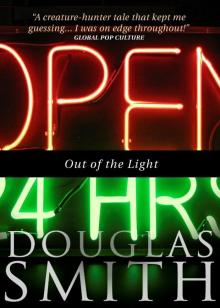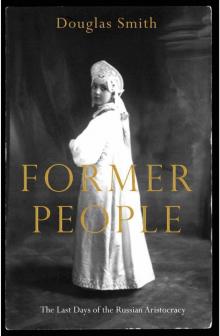- Home
- Douglas Smith
Former People: The Final Days of the Russian Aristocracy Page 2
Former People: The Final Days of the Russian Aristocracy Read online
Page 2
As one of the overlooked stories of the Russian Revolution, the fate of the nobility warrants being told. The destruction of an entire class cannot help eliciting our interest. But there are other reasons as well. The destruction of the nobility was one of the tragedies of Russian history. For nearly a millennium, the nobility, what the Russians called bélaya kost’, literally “white bone” (our “blue blood”), had supplied Russia’s political, military, cultural, and artistic leaders. The nobility had served as the tsars’ counselors and officials, as their generals and officers; the nobility had produced generations of writers, artists, and thinkers, of scholars and scientists, of reformers and revolutionaries. In a society that was slow to develop a middle class, the nobility played a preponderant role in the political, social, and artistic life of the country disproportionate to its relative size. The end of the nobility in Russia marked the end of a long and deservedly proud tradition that created much of what we still think of today as quintessentially Russian, from the grand palaces of St. Petersburg to the country estates surrounding Moscow, from the poetry of Pushkin to the novels of Tolstoy and the music of Rachmaninov.
The story of the Russian nobility also warrants telling since its fate foreshadowed that of other groups in the coming decades. The Bolsheviks’ decision to single out the nobility for political persecution, for the expropriation of its property, for imprisonment, execution, and its designation as “former people” signaled a ruthless, Manichaean mentality that condemned entire collectives of people to harsh repression and even death. What is more, the tactics used against the nobility would be adopted against all of the regime’s supposed class enemies. Lenin saw such enemies everywhere, whether among the more moderate socialists who refused to endorse his radical vision or the Russian peasant slightly better off than his neighbors. He insisted such enemies had to be crushed, and they were. Yet in one of the strange dynamics of the revolution, defeating one’s class enemies was no guarantee of safety, for as the old enemies were defeated, new ones had to be found to justify the continuing struggle for the bright future of the Communist tomorrow. And so just as Stalin later destroyed the Old Bolsheviks, including Yakov Peters, who was arrested and killed in the Great Terror, so too would the entire peasantry be brutally subjugated. A revolution made in the name of the poor would destroy their lives in even greater numbers than those of the rich, the revolution’s original targets.
On a larger scale, the tragedy of the nobles’ fate also foreshadowed future atrocities of the bloody twentieth century when race, class, ethnicity, and religion were used both to incite and to justify oppression and mass killing, from Hitler’s Germany to Pol Pot’s Cambodia and Kambanda’s Rwanda. Chased from their homes and their property expropriated, forced to clean the streets as a form of public humiliation, sent to labor camps, killed with a bullet to the back of the head for the crime of their social origin, Russian nobles were one of the first groups subjected to a brand of political violence that became a hallmark of the past century.
Former People tells the story of how the Russian elite was dispossessed and destroyed between the revolutions of 1917 and the Second World War. It is filled with tales of looted palaces and burning estates, of flights in the night from marauding peasants and Red Army soldiers, of imprisonment, exile, and execution. Yet it is also a story of survival and accommodation, of how many of the tsarist ruling class—abandoned, displaced, and repressed—overcame the psychic wounds inflicted by the loss of their world and struggled to find a place for themselves in the new, hostile order of the Soviet Union. It reveals how even at the darkest depths of the terror, daily life went on: men and women fell in love; children were born; friends gathered; simple pleasures were cherished. Ultimately, Former People is a testament to humans’ remarkable ability to find happiness even amid the most harrowing of circumstances.
How does one begin to describe the destruction of an entire class? It is a process so vast as to defy comprehension. The scale is too large, the point of observation required to encompass it all too remote to make individual lives intelligible. Appreciating the fate of nearly two million people strains the imagination, and we as humans seem somehow constructed to better apprehend, and empathize with, much smaller numbers. Over the past six years I have been fortunate to meet and correspond with many individuals whose families are the subjects of Former People. Their generosity and willingness to share their experiences and collections of family documents have been the most pleasant part of writing this book. Reading dozens of personal accounts and listening to even more stories in homes, archives, and libraries in Russia and the West, I found myself drawn to the experiences of two families in particular—the Sheremetevs and the Golitsyns. Both belonged to the highest level of the nobility, the aristocracy; both had esteemed and ancient histories; both suffered horribly during the revolution and after; both were torn apart, some family members leaving Russia forever; and both left behind a wealth of letters, diaries, memoirs, and photographs that provide the kinds of sources required to write this history in a full, accurate, and convincing manner.
The Golitsyns formed an extensive clan—unlike the titled Sheremetevs—with more than a dozen separate branches at the time of the revolution. One of these descended from Prince Fyodor Golitsyn, a gentleman of the bedchamber in the reign of Catherine the Great and later trustee of Moscow University. Prince Vladimir Golitsyn, Fyodor’s grandson and the long-serving mayor of Moscow, was a contemporary of Count Sergei Sheremetev’s. Whereas the Sheremetevs maintained connections with the court and particularly with the royal family in St. Petersburg, the Golitsyns were a true Moscow family that had little to do with the imperial capital. Nevertheless, the families knew each other—nothing unusual in the small world of the Russian aristocracy—and even though Vladimir (liberal Westernizer) and Sergei (conservative monarchist) could barely tolerate each other, some of their children socialized and worked together. Two of their grandchildren—Yelena Sheremetev and Vladimir Golitsyn, named after his grandfather—fell in love at the Corner House in the early 1920s and married. Thanks to their large numbers, the princely line of the Golitsyns managed to survive in Russia; the Sheremetevs, however, did not.
The lives of several generations of the Sheremetevs and Golitsyns form the unifying thread that runs through Former People. While every noble experienced the revolution and the transition to the new Soviet order in his own way, what happened to the Sheremetevs and Golitsyns, and how they reacted to these events, were true for the majority of the nobility. Their lives were simultaneously exceptional, as is the case for every individual, and ordinary for the members of their class in Russia in those years.1
In late September 1917, a month before the Bolsheviks seized power, Lenin wrote: “A revolution, a real, profound, a ‘people’s’ revolution to use Marx’s expression, is the incredibly complicated and painful process of the death of the old order and the birth of the new social order, of the mode of life of tens of millions of people. Revolution is a most intense, furious, desperate class struggle and civil war.”9 The Bolshevik Revolution was seen by its creators as a Promethean leap into a new era of human history that would leave the past behind forever, and it is largely this half of the story, Lenin’s “birth of the new social order,” that historians have been most intent on exploring. Less well known, though no less important, is the other half: “the death of the old order.”
In 1920, while riding on a train from Siberia to Moscow, Dmitry Fedotoff-White, a former tsarist naval officer, fell into conversation with a group of Red soldiers. He was reading The ABC of Communism, the new popular primer on bolshevism by Nikolai Bukharin and Yevgeny Preobrazhensky, which prompted a discussion on Marxism and the revolution. What struck Fedotoff-White in talking with the men was the large gap between the lofty ideals espoused by the leaders of the revolution and the goals that motivated its foot soldiers. These men had no understanding or even interest in Marxist theory, nor were they concerned with what the new Russian society would l
ook like. Rather, they were motivated by one thing: the desire to destroy the old order. “To all of them, the Bolshevik revolution meant the destruction of monarchy, aristocracy, bureaucracy, and the officer class,” he wrote. “They were all rebels against the old order of things, but that was about all there was to their political feelings.”10
The role of ideology in the revolution and subsequent civil war is a complex one (more than this one interaction implies), but Fedotoff-White makes a crucial point in understanding the sheer ferocity of these years—namely, that the will to destroy was stronger than the will to create and that it was the major force directing the course of events. From the beginning of the revolution, Lenin and the Bolsheviks feared the restoration of the old order; the surest way to prevent this was to rip it out by the roots and kill it. To destroy every vestige of the tsarist past was to deny their enemies any chance to revive it. The Bolsheviks soon realized, however, that they could not survive without the knowledge, skills, and education of the old elite. The workers and peasants, in whose name the Bolsheviks claimed to rule, were simply not qualified to run a vast state. And so began an uneasy collaboration between the old and new masters of Russia that was to last for more than two decades.
The persistence of the former educated elite, many of whom were nobles, stoked frustration and anger amid the classes in whose name the revolution had been made. If the Great October Socialist Revolution signaled a new dawn in human history, why then, many asked, were former counts and princesses, former landowners and tsarist officials still in positions of authority, still living in their homes or on their estates; indeed, why were they even still alive if they belonged to a world that had been buried long ago? Reliance on the former elite posed a threat to the Soviet regime. But it also presented it with a convenient excuse for why the reality of life did not measure up to the regime’s grand promises. If socialism had yet to be achieved, if workers were not living better, if life was still a struggle, then this was not the fault of the leaders or a sign of the flaws within Marxist ideology; rather, it could be explained by the existence of class enemies—of saboteurs, wreckers, White Guards, and monarchists—waging a secret war from within to destroy the Soviet Union. Like other despised minorities, these former people became an easy scapegoat upon which to lay the blame for the Bolsheviks’ failures and a target at which popular anger could be directed without fear of reprisal.
For many Russian nobles the revolution came as no surprise. Even as early as the eighteenth century some far-seeing noblemen could imagine the day when they would be swept away by the masses. At the height of the French Revolution in 1792, Count Semyon Vorontsov, Russia’s ambassador to Great Britain, wrote to his brother back home:
France will not calm down until its vile principles have established themselves in Russia. As I have already told you, this will not be a war for life, but a war till death between those who have nothing and those who own property, and since the latter are few in number so must they inevitably perish. This infection shall become universal. Our distance from this turmoil will protect us for a time; we shall be the last ones, yet nonetheless we shall be victims of this worldwide plague. We shan’t witness it; not you or I, but my son will.11
Vorontsov erred about the revolution’s timing, but he was right that it would be a war to the death between the haves and the have-nots and that the former would lose. For centuries the Russian nobility had lived off the numbing toil of the peasant serfs. Noble landowners, whether cruel tyrants or benevolent masters, enjoyed equally the fruits of this favored status. Their wealth, culture, indeed their entire manner of life were made possible by a harsh system of forced servitude that by the eighteenth century hardly differed from American slavery. The emancipation of the serfs in 1861 did little to change the subservient relationship of the peasant to his former owner. The chasm that separated the world of the masses from the thin layer of the powerful and the privileged lasted right up until 1917.
The peasants had little choice but to tolerate their condition. At times they did rise up, and the results were inevitably violent and bloody. The great rebellions of Stenka Razin and Yemelian Pugachev in the seventeenth and eighteenth centuries, which scorched much of Russia and left tens of thousands dead, inspired hope in the downtrodden and instilled fear in the upper classes. The Russian countryside erupted again in the summer of 1917. This time, however, it would be different, and the peasants would not be subdued. For the nobles on the land it was like waking up and finding oneself trapped behind enemy lines. “It seems we have suffered a shipwreck,” Zenaide Bashkiroff’s grandmother informed her at their estate of Kourbatika. “We are in the position of the Swiss Family Robinson. [. . .] We shall live in perpetual fear of attacks from the wild tribes outside.”12 The “wild tribes” had become even wilder after three years of war. The pointless slaughter of World War I had inured the peasant-soldier to the most horrific violence, and he returned to his village from the front brutalized and shorn of restraint.
Not long after Princess Vera Urusov fled her estate of Kotovka in southern Russia, deserters and peasants tore it apart board by board, stone by stone, before burning what was left to the ground. When they finished, they defiled her father’s grave. Two servants tried to stop them, but they were grabbed by the mob and beheaded; the peasants fed one of the heads to the dogs. Later, when asked to account for the viciousness of their attack on the Urusovs’ property, they replied, “Because they sucked our blood.” A few nobles, Vera among them, were able to see beyond their own personal loss and acknowledge in the tide of violence sweeping across Russia a moment of historical reckoning. She, and her generation of the nobility, would be the ones to pay for the injustice of serfdom. It seems that even at a young age Vera sensed this day would come. One of her favorite childhood games had been pretending she was an aristocrat caught in the French Revolution trying to escape the fury of the mob.13
In many ways the fate of the Russian nobility mirrored that of the French a little more than a century before. In the early 1790s, French nobles became targets of repression and violence as the forces of revolution rallied behind the slogan of “War on the castles, peace to the cottages!” The nobility was stripped of its titles, its ancient privileges, and much of its wealth. At the height of the Terror châteaus were ransacked and plundered, thousands of nobles were imprisoned and killed, and hundreds lost their heads to the guillotine in Paris.14 Nobles who fled the country were branded traitors and enemies; their property was confiscated, and in extreme cases their family members in France were taken hostage. Nobles who remained became known as ci-devants, the first instance of former people. And following a strange dynamic that would be repeated in Russia, as the revolution progressed and the counterrevolutionary threat retreated, the perceived danger the nobles represented and the repressive measures against them increased. When the revolution did not develop as its leaders had promised, they pointed to the nobles as the reason, as would happen in Russia too. Attacking the old elite became an easy way to gain popularity and prove one’s commitment to the cause and to the people.15
But there were important differences as well. Despite the great violence and bloodshed of the French Revolution, what happened in the first few decades of the twentieth century in Russia was on an incomparable scale. Of the 16,594 persons condemned to death by extraordinary courts during the Terror in France, 1,158 of them were nobles, less than 1 percent of the entire noble estate. And when the total number of the Terror’s victims is taken into account, fewer than 9 percent of the victims were nobles.16 The numbers killed in Russia were of an entirely different magnitude. Between 1917 and 1941, the nobility faced several successive waves of terror that likely killed tens of thousands, if not more; given the chaotic manner in which so much of the violence was carried out, accurate records were not kept, and so the exact number will likely never be known. The fate of the Golitsyns offers stark proof of the extent of the terror. Of its many branches extant in 1917, only one survived in Russia;
all the others were killed off or forced into exile. Dozens of Golitsyns were arrested by the Bolsheviks and then shot or died in prison; dozens more simply vanished in the storm of the revolution, and their fate remains unknown. Today there are more Golitsyns in North America than in Russia.17
It was not just the scale of the killing either. When Napoleon, himself a ci-devant, seized power in 1799, he began to bring back the old nobility and to merge it with a new titled elite of his own making. Repressive legislation was abolished, and nobles of the ancien régime slowly began to return to positions of authority. With the final defeat of Napoleon and the restoration of the Bourbons in 1814, the process of revival was complete.18 But in Russia there would be no restoration, neither of the monarchy nor of the nobility. Stalin, unlike Napoleon, was no ci-devant; far from retreating from the revolution’s early extremes, he would reinvigorate them and unleash a new, final war against the state’s class enemies.

 A Bird in the Hand
A Bird in the Hand Out of the Light
Out of the Light Former People: The Final Days of the Russian Aristocracy
Former People: The Final Days of the Russian Aristocracy Spirit Dance
Spirit Dance